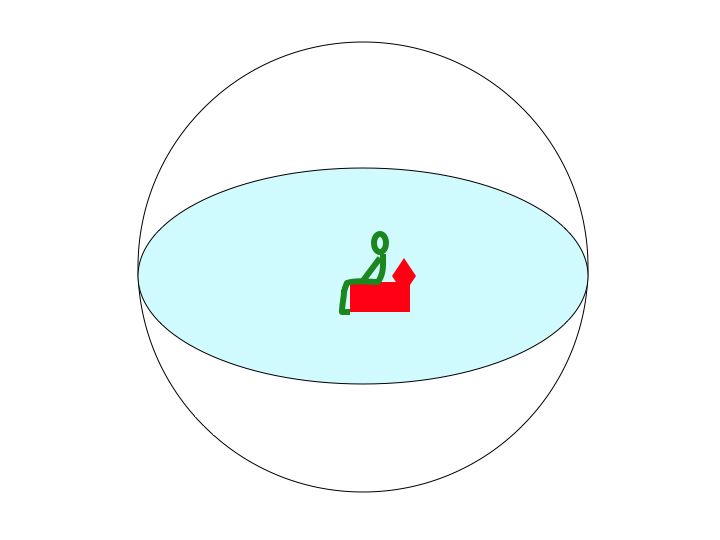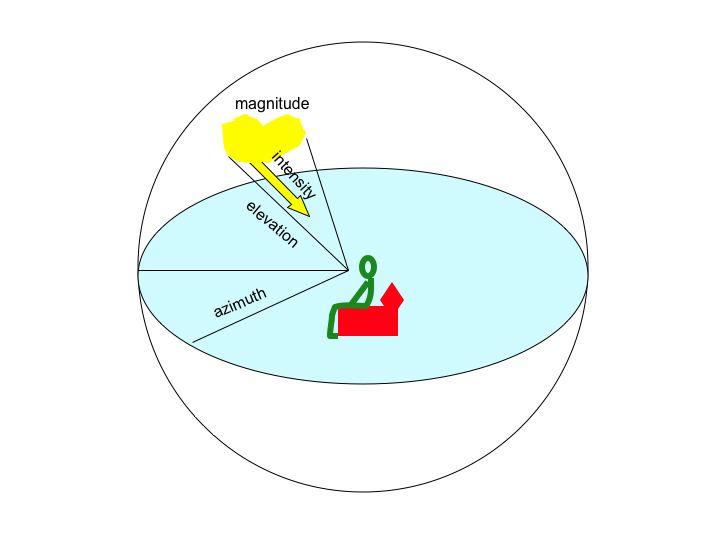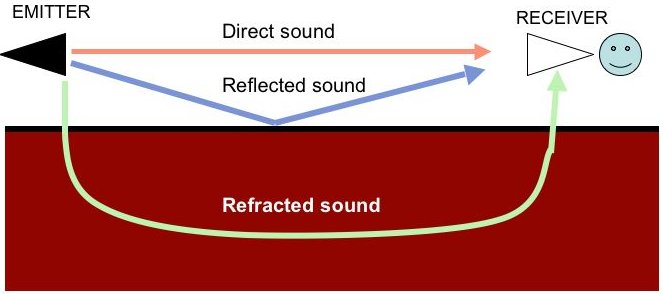Imaginary music (PRELIMINARY ENGLISH VERSION)
[home] <<summary <preceding
next>
[Français
![]() ]
]
To product the music, we need to act on the parameters of the presence dimension: sound intensity (or level) and spatial position of the sound objects.
Two types of sound production can be found.
either the listener, stationary, is the spot of reference, and the sound events occur in front of him or around him: it is the classic situation of the concert; we can compare it with the other types of situations: theater on stage, cinema, lecture, speech, headphone, reading of a book.
either the sound universe is a space where both the sound objects and the listeners move; this situation is very current: noises of the street, carnival, walk, cavalcade, parade of a brass band, living theatre. The public moves in a similar way during the visit of an exhibition of painting or an architectural building, to examine in detail a sculpture, to appreciate a holographic rendering.
In the first case the listener is physically passive (what does not prejudge his intellectual activity of listening), and the effects of presence are only caused by the musical play. By simplification, we shall name this situation "sitting concert".
In the other case the listener is active: he can approach or go away, walk arounds, turn his head, prick up or plug up his ears ; the effects of presence are caused both by the musical play and the initiative of every listener. We shall name this situation "standing concert".
The sitting concert is mostly lived in a dedicated place: the concert hall, which establishes a setting of silence in the urban environment. The standing concert can take place in any place if the environment allows it: the work overlaps then the sound landscape previously existing in this place.
To simplify the continuation of this chapter, we shall limit our analysis in detail to the conditions of the sitting concert.
We shall also approach the special problems put by the electroacoustic diffusion of the music.
Let us imagine the listener in his bubble, in the center of a spherical system..

Figure 1 : a listener sitting within his bubble
To approach the question most simply, we shall define the spatial characteristics of every object in the way the astronomers track down celestial bodies:
|
Angular location :
|
Direction from which the sound seems to come, precised by the azimut (to the left, to the right, in front of, behind) and the elevation (at the top, below), in the same way as we place celestial bodies on the sky. |
|
Distance :
|
Close or remote object, according to its precise or fuzzy received dynamics. |
|
Magnitude :
|
Punctual or massive, the object is perceived in an angle (said solid angle) more or less opened. |
|
Intensity : |
Sound level
|

Figure 2 : spatial characteristics of a sound object
The listening place is a volume limited by more or less reflecting and / or diffusing walls. Let us examine some typical cases.
It is a place of completely extreme and theoretical hearing, where walls are so absorbent as they seem not to exist. By closing eyes we feel suspended in the space. Only the direct sounds from the source to the receiver are perceived. The localization of the sound source is perfect. The phenomena of interferences between different sound sources are very clear: formation of nodes and standing waves of vibration, relations of phases.
The listening in the headphone gets closer to this theoretical case, but without interference between both diffusers.
In open air and without echo (no buildings or reflecting reliefs), the place of hearing gives paradoxically a result rather similar to that of the anechoic room, because there is only a single face constituted by the ground. This one plays nevertheless an important role, because it sends back, by reflection, a part of the sound, and passes on, by refraction, another part, so by changing the color of the sound objects according to the distance :

Figure 3 : analysis of outdoor conditions
Reflection : the figure above shows that the sound reflected by the surface of the ground comes to double the direct sound, all the more intensely as this surface is slick and hard.
Refraction : the sound goes down into the ground upright of the emitter, then it propagates inside the ground, and the receiver gets what goes out to its vertical line. This path in the ground has three very important properties:
only low-pitched sounds can pass through (filtering by the ground) ;
a large part of the vibratory energy remains on-surface without getting lost in the depthes, while most of the direct sounds vanish in the airs, consequently less weakening caused by the distance (cf. the Indians with their ears on the ground) ;
the propagation velocity (3500 m/s) is approximately 10 times bigger than in the air (350 m/s); thus the refracted low-pitched sounds arrive at the receiver before, and more strongly than the direct and reflected sounds.
Conclusion : the ground effect transforms sound objects colors, by changing :
the spectre : the higher frequencies are attenuated with regard to the lower: the sound is less brilliant;
the dynamics : the attack of the sound is soft, because the transitionals formed of high frequencies arrive later to the ear of the listener.
This effect is all the more significant as the distance is big: it is indeed what culturally our ears learned, associating a net and brilliant color with a close sound, and a little contrasted and fuzzy color to a remote sound.
It is the opposite case of that of the anechoic room: almost all the sounds emitted in all the directions are reflected by walls indefinetly. In more restricted dimensions, we obtain a similar effect in a cellar, a corridor of subway, or through an artificial reverberation chamber.
Except at a short distance, the direct sound is flooded in the multiple reflected sounds (reverberation), what hinders to localize the sound sources, and even makes feel to be oneself the sound source, what can be an interesting effect. Finally the lower sounds propagating better, they are facilitated with regard to the higher, except for a very close emitter.
Very often today the auditors listen to a music diffused by loudspeakers, either in concert or at home.
From the point of view of "music diffusers", two types of approach are practised, radically different on the artistic plan :
diffusion, either live or after recording, of a concert having really taken place, or at least having been simulated as such thanks to the techniques of studio: the goal is to listen in "high-fidelity" like the listening in a concert hall;
diffusion of a synthetic electroacoustic work not having to make reference to qualities of imitation.
These two types of approach use nevertheless exactly the same electroacoustic technical conditions to create a sound space.
The loudspeaker is at present the instrument of universal usage. We consider that its main quality should be a strict neutrality, that it does not have to change the sound color and transduce reliably an electric signal into acoustic vibration. It is undoubtly a very difficult exercise, but with a very vain result, because, as soon as the ear left the immediate nearness of the membrane of the device, the parameters of the room of listening begin to intervene: reverberation, transmission by the ground, diffusion by objects in the room. More, the spatial effects (stereophony) require at least two, otherwise more loudspeakers, causing the phenomena of interferences. Certainly, the headphone or the anechoic room would represent an ideal, but which is psychologically badly born due to the effect of total isolation which it implies.
So any system of loudspeakers + room represents inevitably a compromise. An effective way of using it is to plan that a part of the spatial effects will be realized during the diffusion with the system of diffusion (loudspeakers + room) itself.
either by foreseeing average characteristics (ex: the living-room of an averagel music lover) ;
or, for the concert, by preparing a public-address equipment activated by the artist himself (eg: the acousmonium of the Group of Musical Researches, Paris), the gmebophone of the Group of Experimental Music of Bourges, the spatial processor of Pucemuse).
The remote-controlled electronic instruments represent an alternative to the systems of neutral loudspeakers: they are, too, equipped with loudspeakers; these loudspeakers can be specialized for the particular colors of instruments (organs, synthesizers, digital drum kit). Let us note however that the remote control standard in use ( M.I.D.I) is based on the fixed intervals of the traditional music theory, and does not offer standardized parameters for characterization of sounds, except the extensions General MIDI wich are the exclusivity of some manufacturers of synthesis instruments or software.
In the case of the rendering of a concert, the purpose is to get to the listener the illusion, by closing eyes, that he is in the concert hall; the objective is so without ambiguity, and the result more or less achieved with regard to the aimed ideal.
In the case of a pure electroacoustic synthesis, the composer is free to create a totally imaginary virtual universe. His success will be to make share this universe to his listeners.
We shall investigate the conditions of this adventure in the chapters which come now.
Imaginary music ISBN 978-2-9530118-0-7 copyright Charles-Edouard Platel
[home] <<summary <preceding top^ next>